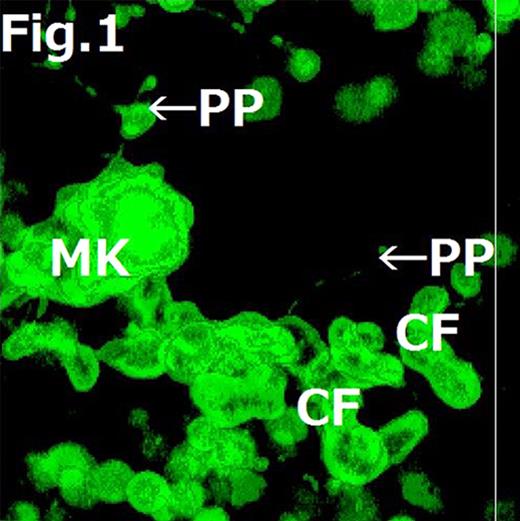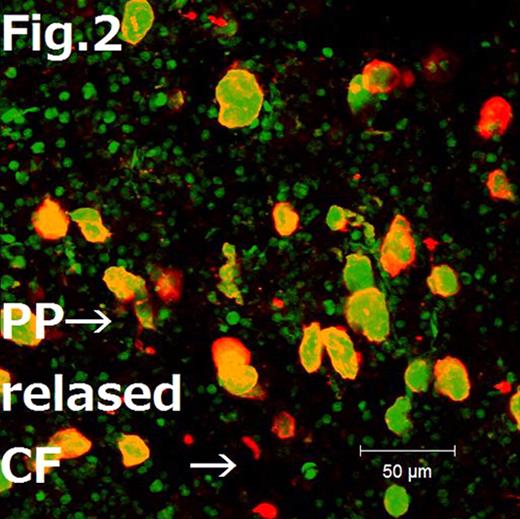Abstract
Abstract 4793
Conventional microscopic evaluation of bone marrow (BM) and in vitro assays have suggested that platelets arise from the proplatelet (PP) that extend from the mature megakaryocytes (MKs) in BM. On the other hand, recently, a study with in vivo imaging showed that MKs routinely release heterogeneous substantial large particles into BM sinusoids (Tobias Junt et. al., Science 317,1767, 2007). They noted that large particles may represent multiple intertwined or single immature proplatelets. However, it has been unclear whether the heterogeneous large particles consist of intertwined strings PPs or “cytoplasmic fragment (CF)”. Thus, in our study, to resolve this riddle, we planed to observe the dynamics of MKs with a modified imaging technique and we have cleared the presence and role of CF in platelet production.
Our study was approved by the Iwate Medical University Institutional Animal Care and Use Committee. 1) Mice: Six- to 8-week-old transgenic C57/BL6 (actin promoter driven EGFP) was used. 2) In vitro time lapse imaging of MK and PPF study: Primary mature MKs from femur BM were cultured for 12 hrs. Time lapse images were taken using Zeiss LSM510 meta confocal microscope (CLM). 3) 3-D reconstitution imaging of fixed BM study: the BM core was removed and immediately fixed and stained with PE-conjugated anti-CD61 antibody. Images were taken using CLM and reconstituted to 3-D images to keep the continuity between MK cell body and PP. 4) BM imaging by Multiphoton intravital microscopy (MP-IVM): Mice were anesthetized, and the frontoparietal skull was exposed. To trace individual MK over time in BM of living mice, time lapse images were taken.
By in vitro time lapse imaging of MK study, it become clear that primary cultured MK formed CF in which morphology was distinctly different from PP (Fig.1). Reversible interconversion between CF and PP was observed also. We observed that CF formation was more augmented in the presence of other BM cells. Because 3-D reconstitution imaging of fixed BM study has a benefit to observe amorphous structure without breaking of spatial continuity, we successfully proved the presence of CF and PP in BM sinusoid clearly (Fig.2). BM imaging by MP-IVM demonstrated that MK formed CF and extended protrusions into sinusoids. We have proved that MK formed and extended CF and PP coincidentally into sinusoids (Fig.3).
We had taken an evidence of presence of CF by in vitro time lapse imaging and 3-D reconstitution imaging. The meaning of reversible interconversion between CF and PP remains unclear in our study. This fact may closely associate with the efficacy of platelet production and avoiding precocious platelet activation in BM. The result that MK produced and extended CF and PP coincidentally suggests that both PP and CF formation may be essential for platelet production process. In conclusion, MK forms PP and CF in living BM. Both PP and CF have critical roles in platelet production mechanism.
No relevant conflicts of interest to declare.
Author notes
Asterisk with author names denotes non-ASH members.




This feature is available to Subscribers Only
Sign In or Create an Account Close Modal